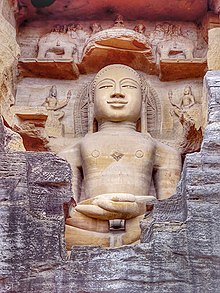

This article needs additional citations for verification. Please help improve this articlebyadding citations to reliable sources. Unsourced material may be challenged and removed.
Find sources: "Gopachal rock-cut Jain monuments" – news · newspapers · books · scholar · JSTOR (November 2016) (Learn how and when to remove this message) |
| Gopachal Parvat Gopachal rock-cut Jain monuments | |
|---|---|

Carving of a Tirthankar
| |
| Religion | |
| Affiliation | Jainism |
| District | Gwalior |
| Deity | Tirthankara |
| Location | |
| Location | Gwalior Fort |
| State | Madhya Pradesh |
| Country | India |
|
Shown within Madhya Pradesh | |
| Geographic coordinates | 26°12′55.1″N 78°10′02.9″E / 26.215306°N 78.167472°E / 26.215306; 78.167472 |
| Architecture | |
| Style | Jainism |
| Creator | Tomars |
| Date established | 7th century |
| Completed | 15th century |
The Gopachal rock-cut Jain monuments, also called Gopachal Parvat Jaina monuments, are a group of Jain rock-cut carvings dated to between the 7th and 15th centuries. They are located around the walls of the Gwalior Fort, Madhya Pradesh. They depict Tirthankaras in seated Padmasana posture as well as standing Kayotsarga posture, in the typical naked form of Jain iconography.
The number of Jain rock shrines at Gwalior, with numerous monumental statues, is unmatched anywhere else. James Burgess wrote: "In the 15th century, during the reign of the Tomar kings, the Jains seem to have been seized with an uncontrollable impulse to convert the cliff that sustains the fort into a great shrine in honour of their religion, and in a few years excavated the most extensive series of Jaina caves known to exist anywhere."[1]
The Gopachal Jain collosi cave temple is one of the Archaeological Survey of India's Adarsh Smarak Monument along with other monuments in the Gwalior Fort.[2]

The Gopachal rock-cut Jain monuments are located on the rock cliffs of the hill topped by the Gwalior Fort, Madhya Pradesh. Gopachal is the old designation of the Gwalior Fort.
There are five clusters of monuments that surround the hill, as can be seen in the 1901 map.[3][4]
Alexander Cunningham noted a Jain temple converted into a mosque just north of the Sas-Bahu temples in the fort containing a Jain inscription of AD 1108.[8] Also within the fort there is an abandoned Jain temple which is now within the Scindia School playground and thus no longer accessible. Several large Jain sculptures are placed within the Teli ka Mandir compound.
The Gwalior city and the fort is connected to other Indian cities by major highways NH 44 and 46 (Asian Highway 43 and 47), a railway station and airport (IATA: GWL). It is located near other historic Hindu and Jain temples from the medieval era.[9][10][11]

The Gopachal rock-cut monuments are a part of nearly 100 Jain monuments found in and around the Gwalior city, but these are dated earlier than the Siddhachal Caves located about 2 kilometres (1.2 mi) north of these monuments. Both monuments were defaced and desecrated around 1527 when the Emperor Babur ordered their destruction.,[12][13] Quote: "In 1527, the Urvahi Jinas were mutilated by the Mughal emperor Babar, a fact he records in his memoirs".[14]Centuries later, the Jain community restored many of the statues by adding back stucco heads on the top of the damaged idols.[12]
The prolific Apabhramsha author Raidhu was responsible for consecrating many of the Jain rock carved images as attested by multiple inscriptions.[15] These include the two colossal images of Shri Adinatha (57 feet) and Shri Chandraprabhu.[16]
Qutb ud-Din Aibak captured the fort from Pratihara in 1196 and held it until his death in 1210. Altmash captured the fort in 1232 and built the fortifications at the Urvahi gate. The Tomars acquired control in 1394 and held it until 1517.
Mughal Emperor Babur conquered Gwalior in AD 1527. Babar ordered the destruction of the Jain statues, as he mentions in his memoirs. The heads of the statues at Urvahi gate and the Ek Patthat ki Bawadi were damaged. The Urvahi gate sculptures were repaired at some later time by the local Jains. The South-West Group and North West group sculptures survived because they were in inconspicuous and hard to reach places. and The Mughals kept control until Muhammad Shah. Scindias, the Maratha clan, took control in 1731. Shortly before that, Jain temples were constructed again in Gwalior city in 1704, including the Jain Golden Temple, Gwalior.[17]
The Gopachal rock-cut monuments depict the Tirthankaras in seated or standing meditating positions. They are not as colossal as some of those found in the Siddhachal Caves, but they are big. The Gopachal monuments include standing and seated Shri Rishabhanatha (Adinatha), Neminatha, Parshvanatha and Shri Mahavirasvami.[12][18][9]
The mulnayak of the complex is a 47 feet (14 m) idol of Parshvanatha, the largest idol of Parshvanatha in lotus position.[19] According to Jains, Tirthankara Parshvanath delivered his discourse (deshna) on this hill.
The nearest airport is Gwalior.
|
| |||||
|---|---|---|---|---|---|
| Gods |
| ||||
| Philosophy |
| ||||
| Branches |
| ||||
| Practices |
| ||||
| Literature |
| ||||
| Symbols |
| ||||
| Ascetics |
| ||||
| Scholars |
| ||||
| Community |
| ||||
| Jainism in |
| ||||
| Jainism and |
| ||||
| Dynasties and empires |
| ||||
| Related |
| ||||
| Lists |
| ||||
| Navboxes |
| ||||
|
Jain Caves in India
| |
|---|---|
| Andhra Pradesh |
|
| Bihar |
|
| Gujarat |
|
| Karnataka |
|
| Madhya Pradesh |
|
| Maharashtra |
|
| Odisha |
|
| Tamil Nadu |
|